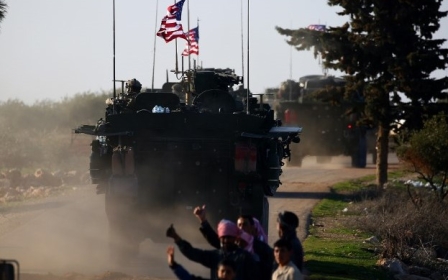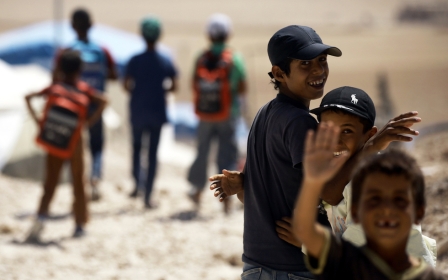In Syria and Sinai, Islamic State will rise again before it falls

President Donald Trump’s recent suggestion that the Islamic State (IS) has been “defeated” was broadly met with disbelief, even by US allies.
It came at a time when IS was engaging in terrorist attacks against the Syrian Democratic Forces (SDF), anti-IS coalition forces and other armed groups in Iraq and Syria, as well as attacks against civilians in Egypt and continued activities in Libya.
Far from being obliterated, IS has transformed into an insurgency. Its current opportunistic mode of operation means that it will take advantage of any openings to prove its viability - though this does not mean a return to the physical “caliphate” anytime soon. As things stand in Egypt and Syria, IS is likely to witness a relative rise in the near future before any fall can occur.
Conspiracy theories
On 6 January, CBS broadcast an interview with Egyptian President Abdel Fattah al-Sisi, despite the Egyptian government attempting to prevent it from airing.
Egyptian authorities did not publicly comment on the matter, but observers have speculated that the state’s opposition was partly due to the interviewer asking about Egypt’s crackdown on protestors in Cairo in 2013, and partly because of Sisi’s unprecedented announcement about close cooperation with Israel in combatting IS in Sinai.
Sinai became the new locus of IS activity after the group’s loss of territory in Iraq and Syria. Some Egyptian pro-government news sites, as well as Russian news sites, accused Turkey of facilitating the transfer of IS fighters from Syria into Sinai.
Some Turkish news sites, on the other hand, spoke of US facilitation for the transfer of IS fighters from Raqqa into Sinai after a deal brokered with the SDF.
There is no evidence to prove either theory. Sinai did become an active front in addition to Syria and Iraq, but this was met with increasing Israeli intervention to try to block this growth.
With potential escalation looming on both sides, the unfolding scenario is far from the end of the fight against IS in the Sinai, which both the Egyptian government and the Israelis had hinted at last year
Reports of Israeli help for Egyptian security forces in Sinai have been circulating in the Israeli and international media for at least two years, but Israeli military support was meant to be largely covert, especially after IS posted a video in which one of its fighters in Sinai displayed to the camera remnants of missiles with Hebrew writing on them.
Sisi’s admission is likely to be paraded by IS as proof of its credibility, and used to rally more support in Sinai and elsewhere. Now that the admission has been made public, it will also be used by the Egyptian government to send a message to IS that the group is facing a mighty force.
With potential escalation looming on both sides, the unfolding scenario is far from the end of the fight against IS in the Sinai, which both the Egyptian government and the Israelis had hinted at last year.
Guerilla warfare
In Syria, the SDF recently posted a video of a raid against IS remnants in the town of Hajin, which international media labelled as the last stand for IS. But as in Sinai, the battle against IS in Syria is far from over.
After its military defeat in Iraq, the group moved many of its foreign fighters from Iraq into Syria. Some Iraqi IS fighters made a similar move.
When Turkey began attacking the SDF a few months ago, the group diverted some of its attention from fighting IS, allowing the latter to increase the scope of its attacks, including targeted assassinations of some SDF members. And while IS has largely lost territorial control in Syria, it retains a presence in various pockets in the east, north and south, enabling its fighters to engage in guerilla warfare.
IS fighters can still be found in the rough terrain of the western deserts around Anbar, and the deserts south of Deir Ezzor and east of Palmyra; they are able to cross the Iraqi-Syrian border in either direction in the surrounding area. They are benefitting from the end of the large-scale military campaign against them in Iraq, but are finding in Syria a more hospitable environment.
In northern Syria, rising popular anger towards Hayat Tahrir al-Sham is diverting attention from the remaining IS cells in the area. In the south, IS attacked the civilian Druze community in Sweida last year.
Useful enemy
The Syrian regime has played a role in facilitating some IS activities, whenever those activities were deemed beneficial to regime interests. The Sweida attacks conveniently punished the Druze community for not toeing the regime line about military conscription.
Attacks against the SDF foster a sense of insecurity in areas it controls, which Damascus hopes will push civilians to see in the regime a better security option than the SDF.
With the US appearing to backtrack on Trump’s announcement about withdrawing from Syria imminently, the SDF is likely to continue to exist in the foreseeable future - but with that comes sustained targeting by IS.
With the IS leadership pushed towards Syria, different cells affiliated with the group are increasing their activities to show that IS is far from over.
All this indicates a rough start to 2019 in both Sinai and Syria.
- Lina Khatib is the head of the Middle East and North Africa Programme at Chatham House. You can follow her on Twitter @LinaKhatibUK.
The views expressed in this article belong to the author and do not necessarily reflect the editorial policy of Middle East Eye.
Photo: An image grab taken from a propaganda video released in March 2014 shows IS fighters raising their weapons (Handout/al-Furqan Media/AFP).
This article is available in French on Middle East Eye French edition.
Middle East Eye propose une couverture et une analyse indépendantes et incomparables du Moyen-Orient, de l’Afrique du Nord et d’autres régions du monde. Pour en savoir plus sur la reprise de ce contenu et les frais qui s’appliquent, veuillez remplir ce formulaire [en anglais]. Pour en savoir plus sur MEE, cliquez ici [en anglais].






